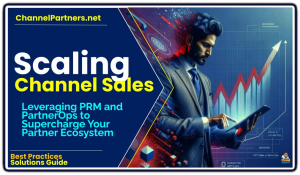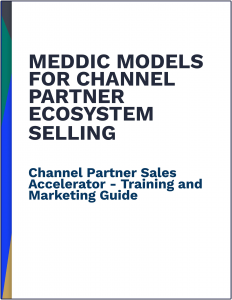Scaling High Performance Partner Selling – Leveraging MEDDIC with Channel Partners
The MEDDIC framework is a widely respected sales qualification methodology designed to help sales teams systematically assess and close complex B2B deals with greater predictability and efficiency.
 The MEDDIC sales methodology is a structured framework used primarily in B2B sales to qualify prospects, improve forecasting accuracy, and close deals more effectively.
The MEDDIC sales methodology is a structured framework used primarily in B2B sales to qualify prospects, improve forecasting accuracy, and close deals more effectively.
It’s particularly popular in complex, enterprise-level sales environments where understanding the buyer’s needs and decision-making process is critical.
MEDDIC
The MEDDIC framework is a widely respected sales qualification methodology designed to help sales teams systematically assess and close complex B2B deals with greater predictability and efficiency.
Originally developed in the 1990s by Dick Dunkel and Jack Napoli at Parametric Technology Corporation (PTC), it provides a structured approach to understanding a customer’s buying process, identifying key factors that influence the sale, and ensuring alignment between the seller’s solution and the buyer’s needs.
The acronym MEDDIC stands for six core components: Metrics, Economic Buyer, Decision Criteria, Decision Process, Identify Pain, and Champion. Here’s a breakdown of each element:
- Metrics: This focuses on quantifying the value your solution brings to the customer. It involves identifying measurable outcomes—such as cost savings, revenue growth, or efficiency gains—that justify the investment. For example, if your product reduces downtime by 20%, you’d tie that metric to the customer’s specific goals to demonstrate ROI.
- Economic Buyer: This is the person with the ultimate authority to approve the purchase and allocate budget. Identifying and engaging this individual is critical, as they hold the financial reins. MEDDIC emphasizes building a relationship with the economic buyer to ensure your solution aligns with their priorities.
- Decision Criteria: These are the specific factors the customer uses to evaluate and choose a solution. They might include technical requirements, cost, scalability, or vendor reputation. Understanding these criteria allows you to tailor your pitch and differentiate your offering from competitors.
- Decision Process: This maps out the steps the customer follows to make a purchasing decision, including who is involved, what approvals are needed, and the timeline. By clarifying this process, you avoid surprises and can proactively address potential roadblocks.
- Identify Pain: This step involves uncovering the customer’s core challenges or problems that your solution can address. It’s not enough to assume pain exists—you must dig deep to understand its scope, impact, and urgency (e.g., lost revenue due to inefficiencies) to position your product as the remedy.
- Champion: A champion is an internal advocate within the customer’s organization who believes in your solution and helps navigate the sale. They’re typically someone affected by the pain, motivated by the metrics, and influential enough to sway decision-makers.
MEDDIC’s strength lies in its disciplined, customer-centric approach, ensuring sales teams focus on opportunities with the highest likelihood of success. By qualifying deals rigorously—rather than chasing every lead—it minimizes wasted effort and boosts close rates.
It’s particularly effective in high-stakes, enterprise-level sales where multiple stakeholders and complex decisions are the norm. When applied to channel partnerships, as explored in your book concept, MEDDIC adapts to align diverse players toward a shared outcome, making it a versatile tool for ecosystem co-selling.
 EBook: MEDDIC MODELS FOR CHANNEL PARTNER ECOSYSTEM SELLING
EBook: MEDDIC MODELS FOR CHANNEL PARTNER ECOSYSTEM SELLING
By adapting the MEDDIC framework—Metrics, Economic Buyer, Decision Criteria, Decision Process, Identify Pain, and Champion—to the unique challenges and opportunities of channel ecosystems, we unlock a powerful methodology that drives mutual success.
Whether you’re a sales leader navigating partner networks, a channel manager fostering co-selling synergy, or an executive aiming to amplify revenue through strategic alliances, this book offers the insights, tools, and real-world examples to elevate your game.
Prepare to rethink collaboration, harness the full potential of your ecosystem, and redefine what’s possible in the art of the sale.



